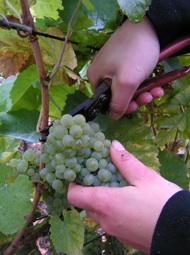
Features
Fruit
Production
Improving hardiness in grapes
September 28, 2009 By USDA Agricultural Research Service
 September 25, 2009 —
September 25, 2009 —
Agricultural Research Service (ARS) scientists are a step closer to improving
the hardiness of grape varieties that can be damaged and destroyed by fall
frosts and cold winters in North American vineyards.
September 25, 2009 —
Agricultural Research Service (ARS) scientists are a step closer to improving
the hardiness of grape varieties that can be damaged and destroyed by fall
frosts and cold winters in North American vineyards.
 |
|
Grapes, like many other
woody plants, stop growing and drop their leaves in the fall, entering a
dormant phase that allows them to prepare for and survive the winter.
Understanding the timing of this seasonal growth cessation in grapes is a key
objective for scientists. If they can find genes that control it, they can help
breeders develop more marketable cold-tolerant grapes.
The wild grape species
Vitis riparia is unusual among wild grapes because it stops growing when the
day length drops below 13 hours, which occurs in late August in upstate New
York, according to Amanda Garris, a geneticist at the ARS Grape Genetics
Research Unit in Geneva, N.Y. Most other grape species are not sensitive to day
length.
Garris, ARS molecular
biologist Christopher Owens, James Luby of the University of Minnesota, and
Anne Fennel of South Dakota State University want to identify genes for day
length sensitivity in V. riparia.
The researchers crossed V.
riparia with Seyval, a hybrid grape insensitive to day length. They raised some
of the offspring in fields, with natural fluctuations of day length, rainfall
and temperature. Others they raised in greenhouses where water and temperature
levels remained constant, but artificial day lengths were gradually reduced to
mimic conditions outside.
They evaluated growth
cessation patterns and mapped differences found in 120 DNA markers and six
genes. They discovered that in greenhouse-grown grapevines, a region of
chromosome 13 is responsible for day-length-induced growth cessation. But in
the field, the interaction of multiple cues such as day length, rainfall and
temperature fluctuations is more likely to explain the timing of growth
cessation.
The study, considered a
preliminary step toward identification of genes for day length sensitivity and
growth cessation, was recently published in the Journal of the American Society
of Horticultural Science.
Print this page